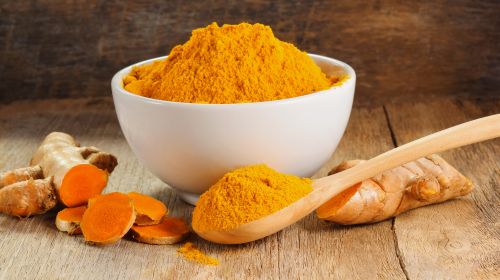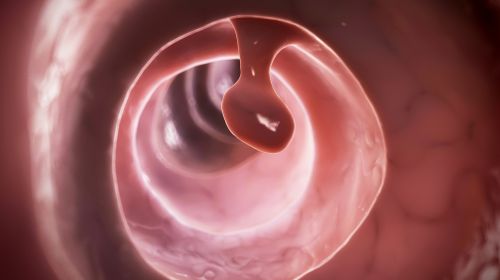An inflammation of abnormal bulges of the intestine (diverticulum) is called diverticulitis. The disease can be acute or chronic. A diet rich in fiber can counteract diverticulitis.
- Sudden pain, often after eating, is typical of diverticulitis.
- © iStock.com/dragana991
Diverticulitis is inflammation of one or more small, sac-like protuberances of the intestinal mucosa (diverticula), which mainly occur in the large intestine (colon). If left untreated, it can lead to serious complications such as intestinal obstruction or peritonitis. A distinction is made between acute and chronic diverticulitis.
At a glance:
Diet for diverticulitis
Obesity and a low-fiber diet can promote the occurrence of diverticulitis.
The following nutritional recommendations can prevent diverticulitis and, if there is already a disease, new inflammation:
- high-fiber diet (lots of whole grains, fiber-rich vegetables and fruits)
- Make greater use of finely ground whole grain products: the softer and finer the stool, the easier it is to pass through the intestine and the less likely it is that stool residues will get stuck in the protuberances.
- drink enough fluids (water, unsweetened herbal teas)
- Chew food thoroughly
- Limit consumption of red meat and animal fat
- Avoid or reduce excess weight
- Limit alcohol consumption or avoid it completely
Fasting in acute diverticulitis
If there is an uncomplicated diverticulitis, the doctor treating the patient usually prescribes a lack of food (fasting), combined with the intake of plenty of fluids (e.g. broth or lukewarm tea with glucose) to relieve the digestive tract and counteract the inflammation.
If the inflammation subsides, a slow build-up of food (first pureed, easily digestible dishes such as mashed potatoes, then gradually more solid foods) is important.
Symptoms: How does diverticulitis manifest itself?
Diverticulosis usually does not cause symptoms. However, if one or more diverticula become inflamed, the extent of the complaints depends on the area affected. The most important symptom of diverticulitis is sudden, often persistent and radiating severe pressure pain in the lower abdomen, which is exacerbated by eating and gets better after bowel movements.
Stages of diverticulitis
| stage | description | symptoms |
| 0 | asymptomatic diverticulosis | Random finding without symptoms |
| I | acute uncomplicated diverticulitis | Pain, the diverticulum inflammation is limited to the colon wall (colon wall) |
| II | acute complicated diverticulitis | severe pain, the inflammation parameters in the blood are greatly increased, the inflammation can be detected by computer tomography (CT) |
| III | chronic diverticulitis | Persistent or recurring pain, the intestinal wall shows anatomical changes such as fistulas or narrowing (stenoses) |
Other possible symptoms of diverticulitis are:
Probability and causes of diverticulitis
The likelihood of the occurrence of diverticula (diverticulosis) – and thus the risk of developing diverticulitis – increases with age: study results show that in the western industrialized countries around 13 percent of all under 50s, 30 percent of all 50- up to 70 years old, 50 percent of all 70 to 85 year olds and 66 percent of all over 80 year olds have protuberances in the large intestine. The causes are unclear: Genetic movement disorders of the large intestine, weak points in the intestinal mucosa, overweight and a low-fiber or meat-heavy diet are considered.
The diverticula and their surroundings can become inflamed, for example, through the accumulation of (hardened) stool components, which contain numerous germs. The likelihood of someone with diverticulosis developing diverticulitis is around ten percent. The following factors seem to increase the risk of diverticulitis:
- chronic pre-existing conditions such as high blood pressure
- a weakened immune system
- Certain medications (cortisone and non-steroidal anti-inflammatory drugs such as ibuprofen or diclofenac)
Diverticulitis is much less common in developing countries than in industrialized countries, which is probably related to diet, but also to different life expectancies.
How is diverticulitis diagnosed?
If you suspect inflamed bowels, specialists in internal medicine with the additional designation gastroenterology are the right contacts. Because the symptoms of diverticulitis can also indicate other diseases such as irritable bowel syndrome, careful differential diagnosis is important.
First of all, the doctor inquires about the specific complaints, previous illnesses, taking medication and lifestyle factors such as diet or tobacco consumption (medical history). Then he gropes, pats and listens to the abdomen, measures fever and performs a high-resolution ultrasound (sonography) and, if necessary, a rectal examination. In the case of severe complaints, blood is drawn so that the inflammation values (C-reactive protein, white blood cells, blood sedimentation rate) can be determined in the laboratory. In order to rule out complications such as a fistula in the bladder and resulting urinary tract infections, the patient's urine is usually also examined.
According to the guideline, the diagnosis of diverticulitis is only confirmed when inflammatory changes in existing diverticula have been demonstrated by imaging methods. In case of an unfavorable position of the inflamed diverticula, which cannot be seen by ultrasound, a computed tomography (CT) must also be arranged. Complications such as pus accumulation can also be detected more reliably using CT.
Colonoscopy is avoided in acute diverticulitis because it represents a greatly increased risk of an intestinal injury. However, to rule out colorectal cancer, which in some cases coexists with diverticulitis, it is recommended to do this examination after the inflammation has healed – especially if the patient is older than 55 and the last colonoscopy was more than five years ago.
How is diverticulitis treated?
Therapy for diverticulitis depends on the degree of inflammation. Outpatient treatment is usually possible for otherwise healthy patients. In the event of severe courses or previous illnesses, hospitalization may be useful.
In addition to the adapted diet described above, the person concerned should be physically gentle. Patients with diverticulitis are often fed artificially (intravenously) during inpatient treatment.
Many doctors also prescribe an antibiotic. However, the importance of antibiotic therapy has decreased in recent years: According to a recent study, more than 90 percent of patients with acute uncomplicated diverticulitis can be cured without the use of antibiotics.
If there is a complicated diverticulitis, the inflamed sections of the intestine usually have to be surgically removed.
Emergency surgery is necessary if:
- the intestine is freely perforated (stool exits into the abdominal cavity)
- the peritoneum is inflamed (peritonitis)
- blood poisoning (sepsis)
In order to accelerate the healing process, a temporary artificial bowel exit (stoma) is usually placed in the course of the operation, which can later be removed in another operation.
If there is a so-called covered intestinal breakthrough (the perforation site is covered by a neighboring organ so that there is no connection to the free abdominal cavity) with abscess formation (pus accumulation), the patient is usually treated in hospital for up to two weeks before undergoing surgery , If necessary, the pus must be drained through a thin tube (drainage) during local anesthesia. The affected intestinal sections are removed surgically about six weeks later. An artificial intestinal exit can usually be dispensed with here.
Repeated uncomplicated flare-ups of diverticulitis can, according to many specialists, be treated conservatively if this form of therapy works well. Careful risk-benefit analysis by experienced medical professionals (internal gastroenterologists, surgeons) is important.
Possible reasons for an operation with a chronic course:
- Presence of an immune deficiency
- Taking immunosuppressive drugs such as cortisone, methotrexate and azathioprine
- the repeated inflammation causes the intestine to become narrow (stenosis)
- a fistula (permanent connection) to another organ (e.g. the bladder) has formed
- the quality of life is significantly affected by the flare-ups
A planned diverticulitis operation is carried out in an inflammation-free period and usually minimally invasively (over small incisions using keyhole technology). This is not always possible in an emergency operation.
How does diverticulitis develop?
Some sufferers have to deal with complications such as free perforation of the intestinal wall even when acute diverticulitis occurs for the first time, others have no more extensive problems even with regular inflammation.
Diverticulitis is basically curable. Around 95 percent of all acute diverticulitis is uncomplicated. The risk of recurrence (recurrent diverticulitis) after acute uncomplicated diverticulitis is rather low at 20 percent. With every further flare of inflammation, however, it increases.
Acutely complicated diverticulitis has a much poorer prognosis: Here, the majority of those affected fall ill again within a few months – half of them more severely than at the first relapse.
How can diverticulitis be prevented?
If intestinal protuberances have formed, regression is not possible. To avoid the formation of diverticula, it is recommended:
- adapted diet (see above)
- to move a lot
- Reduce excess weight
- not smoking
If you already have diverticula in your intestine, you should avoid taking the above-mentioned measures (if possible) with critical medications such as non-steroidal painkillers (NSAIDs) or cortisone preparations in order to reduce the risk of diverticulitis.

